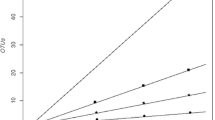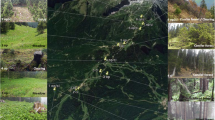Abstract
The great increase in the abundance and phylogenetic diversity of Flavobacterium spp. within a few hundred meters downstream of the discharge site of the Westerhöfer Bach, a hardwater rivulet, raised the question whether adjacent soil may serve as a reservoir of bacteria not detected in discharge water. To address this question, denaturing gradient gel electrophoresis (DGGE) analyses of the V3 region of Flavobacterium 16S rRNA genes were performed on DNA from nine soil samples and five rivulet sites. The resulting patterns were tested for the significance of differences between the sampling habitats using the nonparametric analysis of similarities and multidimensional scaling procedures. Even though both habitats were sampled in two consecutive years DGGE patterns of soil and downstream water samples showed significant overlap (R = 0.614). Sequencing of 57 DGGE bands resulted in 30 different sequences, which, on the basis of BLAST analyses, were between 96% and 100% similar to published clone, DGGE, and strain sequences from a wide range of different habitats. Forty-five percent of the highly similar sequences included those of isolates from the Westerhöfer Bach, while the other sequences were more closely related to clones and cultures from other habitats, especially agricultural soil. Based on these results we suggest that the increase in flavobacterial strain diversity and abundance in the rivulet may originate from soil microflora.



Similar content being viewed by others
References
Altschul SF, Madden TL, Schäffer AA, Zhang J, Zhang Z, Miller W, Lipman DJ (1997) Gapped BLAST and PSI-BLAST: a new generation of protein database search programs. Nucleic Acids Res 25:3389–3402
Amann RI, Ludwig W, Schleifer KH (1995) Phylogenetic identification and in situ detection of individual microbial cells without cultivation. Microbiol Rev 59:143–169
Brambilla E, Päuker O, Cousin S, Steiner U, Reimer A, Stackebrandt E (2007) High phylogenetic diversity of Flavobacterium spp. isolated from a hardwater creek, Harz Mountains, Germany. Org Div Evol 7:145–154
Clarke KR, Gorley RN (2001) PRIMER v5: user manual/tutorial. PRIMER-E, Plymouth UK (available at: http://www.primer-e.com/)
Cousin S, Brambilla E, Yang J, Stackebrandt E (2008) Culturable aerobic bacteria from the upstream region of a karst water rivulet. Int Microbiol 11:91–100
Cousin S, Päuker O, Stackebrandt E (2007) Flavobacterium aquidurense sp. nov. and Flavobacterium hercynium sp. nov., from a hard-water creek. Int J Syst Evol Microbiol 57:243–249
Dechesne A, Pallud C, Bertolla F, Grundmann GL (2005) Impact of the microscale distribution of a Pseudomonas strain introduced into soil on potential contacts with indigenous bacteria. Appl Environ Microbiol 71:8123–8131
Farrant J (1980) General observations on cell preservation. In: Ashwood-Smith MJ, Farrant J (eds) Low temperature preservation in medicine and biology. Pitman Medical, Kent, UK, pp 1–18
Gich F, Schubert K, Bruns A, Hoffelner H, Overmann J (2005) Specific detection, isolation, and characterization of selected, previously uncultured members of the freshwater bacterioplankton community. Appl Environ Microbiol 71:5908–5919
Hugenholtz P, Goebel BM, Pace NR (1998) Impact of culture-independent studies on the emerging phylogenetic view of bacterial diversity. J Bacteriol 180:4765–4774
Mayerberger JM, Huzinga KM, Isaacs-Cosgrove N, Marsh TL (2007) Submitted to the EMBL/GenBank/DDBJ databases, 20 January
McCammon SA, Bowman JP (2000) Taxonomy of Antarctic Flavobacterium species: description of Flavobacterium gillisiae sp. nov., Flavobacterium tegetincola sp. nov., and Flavobacterium xanthum sp. nov., nom. rev. and reclassification of [Flavobacterium] salegens as Salegentibacter salegens gen. nov., comb. nov. Int J Syst Evol Microbiol 50:1055–1063
Nicol GW, Glover LA, Prosser JI (2003) Spatial analysis of archaeal community structure in grassland soil. Appl Environ Microbiol 69:7420–7429
Schwarz JIK, Eckert W, Conrad R (2007) Community structure of Archaea and Bacteria in a profundal lake sediment Lake Kinneret (Israel). Syst Appl Microbiol 30:239–254
Shiraishi F, Reimer A, Bissett A, de Beer D, Arp G (2008) Microbial effects on biofilm calcification, ambient water chemistry and stable isotope records in a highly supersaturated setting (Westerhöfer Bach, Germany). Paleogeograph Paleoclim Paleoecol 262:91–106
Van der Gucht K, Sabbe K, De Meester L, Vloemans N, Zwart G, Gillis M, Vyverman W (2001) Contrasting bacterioplankton community composition and seasonal dynamics in two neighbouring hypertrophic freshwater lakes. Environ Microbiol 3:680–690
Van der Gucht K, Vandekerckhove T, Vloemans N et al (2005) Characterization of bacterial communities in four freshwater lakes differing in nutrient load and food web structure. FEMS Microbiol Ecol 53:205–220
Van Trappen S, Vandecandelaere I, Mergaert J, Swings J (2004) Flavobacterium degerlachei sp. nov., Flavobacterium frigoris sp. nov. and Flavobacterium micromati sp. nov., novel psychrophilic bacteria isolated from microbial mats in Antarctic lakes. Int J Syst Evol Microbiol 54:85–92
von Wintzingerode F, Göbel UB, Stackebrandt E (1997) Determination of microbial diversity in environmental samples: pitfalls of PCR-based rRNA analysis. FEMS Microbiol Rev 21:213–229
Weon HY, Song MH, Son JA, Kim BY, Kwon SW, Go SJ, Stackebrandt E (2007) Flavobacterium terrae sp. nov. and Flavobacterium cucumis sp. nov., isolated from greenhouse soil. Int J Syst Evol Microbiol 57:1594–1598
Zwart G, Huismans R, van Agterveld MP et al (1998) Divergent members of the bacterial division Verrucomicrobiales in a temperate freshwater lake. FEMS Microbiol Ecol 25:159–169
Acknowledgments
I thank Erko Stackebrandt for the sequence analysis and Orsola Päuker for the preparation of bacteria-loaded filters. This project is part of the Research Unit 571 “Geobiology of Organo- and Biofilms,” funded by the German Research Foundation (Sta 184/19-2; DFG-FOR 571; publication 35).
Author information
Authors and Affiliations
Corresponding author
Rights and permissions
About this article
Cite this article
Cousin, S. Flavobacterial Community Structure in a Hardwater Rivulet and Adjacent Forest Soil, Harz Mountain, Germany. Curr Microbiol 58, 409–415 (2009). https://doi.org/10.1007/s00284-008-9323-5
Received:
Revised:
Accepted:
Published:
Issue Date:
DOI: https://doi.org/10.1007/s00284-008-9323-5




